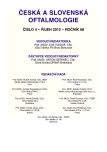Choroidal Melanoma Stage T1 – Comparison of the Planning Protocol for Stereotactic Radiosurgery and Proton Beam Irradiation
Authors:
A. Furdová 1; J. Růžička 2; M. Šramka 3; G. Králik 3; M. Chorvath 3; P. Kusenda 1
Authors‘ workplace:
Klinika oftalmológie Lekárskej fakulty Univerzity Komenského a Univerzitnej nemocnice, Nemocnica Ružinov, Bratislava, prednosta: doc. MUDr. Vladimír Krásnik, PhD.
1; Katedra jadrovej fyziky a biofyziky, Fakulta matematiky, fyziky a informatiky Univerzity Komenského, Bratislava, vedúci katedry doc. RNDr. Karol Holý, CSc.
2; Klinika stereotaktickej rádiochirurgie OÚSA a Vysokej školy zdravotníctva a sociálnej práce sv. Alžbety, Bratislava, prednosta prof. MUDr. Miron Šramka, DrSc.
3
Published in:
Čes. a slov. Oftal., 68, 2012, No. 4, p. 156-161
Category:
Original Article
Overview
Objective:
Comparison of two methods of irradiation of patients with malignant choroidal melanoma – stereotactic radiosurgery and proton beam irradiation. External (non-contact) applied irradiation is used as a source of accelerated protons, respectively helium ions. This method allows applications of ionizing irradiation also despite the low radiosensitivity of cells of malignant melanoma of the uvea (MMU). External source of ionizing radiation is modulated current energy electrons, protons or neutrons, accelerated in linear accelerators. From the external medium voltages resources (4-16 MeV) are irradiated tissues with target dose of 5.0–24.0 Gy. Volume protons permeate straight the structures of the eye to a certain distance. The use of proton radiation density of ionized protons increases in the vicinity of the impact due to energy losses for electrons interacting with the environment. At the end of the track there is a huge increase in the ionization dose (“Bragg spike”). Therefore, the structures surrounding the eye at the point of entry and little affected and increasing the dose at the end of the proton beam is ideal for the desired therapeutic effect. Fractionated application is also possible.
Case report:
In December 2011 we performed stereotactic radiosurgery to treat female patient (born 1939) with malignant melanoma of the choroid stage T1 N0 M0. Plan has been drawn up for stereotactic irradiation – model for linear accelerator Clinac, Corvus planning system ver. 6.2, verification and OmniPro IMRT planning system Liebinger ver. 4.3. Patient characteristics were compared with the virtual plan for proton radiation therapy, and we used the scheme in Physical parameters FIAN-technical center in the Russian Federation. We compared both planning protocols and assess in particular the extent of radiation surrounding non-tumor tissue.
Results:
When comparing the two planning schemes irradiation levels of surrounding tissues and risk structures (lens, optic nerve, chiasm) in both methods were corresponding to the required standard.
Conclusion:
Treatment of uveal melanoma through proton beam irradiation in Slovakia is not available yet, although it has several advantages, such as fractionation and the possibility of achieving a higher dose of irradiation to deposit (more than 50.0 Gy). The fundamental difference between the two methods for an eye is particularly the possibility of proton beam irradiation exposure of tumor of iris and ciliary body, which can not be solved through stereotactic radiosurgery. The dose to the tumor during irradiation can be optimized. The model device allowed us to make OPTMI – Therapy (Proton Treatment with Optimized Modulated Intensity).
Key words:
malignant melanoma of the choroid, stereotactic radiosurgery for uveal melanoma, proton beam irradiation
Sources
1. Damato, B., Kacperek, A., Chopra, M., et al.: Proton beam radiotherapy of choroidal melanoma: the Liverpool-Clatterbridge experience, Int J Radiat Oncol Biol Phys, 2005; 1: 62, 5, 1405–11.
2. Egger E. et al: Maximizing local tumor control and survival after proton beam radiotherapy of uveal melanoma, Int J Radiat Oncol Biol Phys, 2001; 51: 1348–47.
3. Furdová, A., Chorváth, M., Waczulíková, I., et al.: No differences in outcome between radical surgical treatment (enucleation) and stereotactic radiosurgery in patients with posterior uveal melanoma, Neoplasma, 2010; 57 (4): 377–381.
4. Furdová, A., Oláh, Z.: Malígny melanóm v uveálnom trakte, Asklepios, Bratislava, 2002, 175 s.
5. Furdová, A., Oláh, Z.: Nádory oka a okolitých štruktúr, CERM, Brno, 2010, 151s.
6. Furdova, A., Strmen, P., Sramka, M.: Complications in patients with uveal melanoma after stereotactic radiosurgery and brachytherapy, Bratislava Medical Journal – BLL, 2005; 106 (12): 401–406.
7. Furdova, A., Strmen, P., Waczulikova, I., et al.: One-day session LINAC-based stereotactic radiosurgery of posterior uveal melanoma, Eur J Ophthalmol, 2012, Mar, 22 (2): 226–35.
8. Gragoudas E. et al.: Evidence-based estimates of outcom in patients irradiated for intraocular melanoma, Arch Ophtalmol, 2002; 120: 1665–71.
9. Monzulj, G.D., Gladilina, I.A.: Radiacionnaja biologija. Radioekologija, 2005, 6, p. 670–674.
10. Oelfke, U.: Intensity modulated radiotherapy with highenergy photon and hadron beams. Dostupné na internete: http:// www.scribd.com/doc/95017648/Intensity-Modulated-Radiotherapy-With-High
11. PTCOG: Particle Therapy Co.Operative Group, Hadron Therapy Patient Statistics PTCOG50 Dostupné na internete: http://ptcog.web.psi.ch).
12. Weber, D.C., Bogner, J., Verwey, J., et al.: Proton beam radiotherapy versus fractionated stereotactic radiotherapy for uveal melanomas: A comparative study. Int J Radiat Oncol Biol Phys, 2005; 1, 63, 2: 373–84.
13. ZAO PROTOM, Dostupné na internete: www.protom.ru
14. Zytkovicz, A., Daftari, I., Phillips, T.L. et al.: Peripheral dose in ocular treatment with Cyberknife and Gamma Knife radiosurgery compared to proton radiotherapy, Phys Med Biol, 2007; 52: 5957–5971.
Labels
Maxillofacial surgery OphthalmologyArticle was published in
Czech and Slovak Ophthalmology

2012 Issue 4
Most read in this issue
- Sub-internal Limiting Membrane Haemorrhage Treated by Pars Plana Vitrectomy
- Perforated Punctum Plugs in Treatment Lacrimal Punctal Stenosis
- Efficacy and Tolerability of Preservative-free Tafluprost 0.0015 % in the Treatment of Glaucoma and Ocular Hypertension
- Extrascleral Overgrowth of Malignant Choroidal Melanoma after Endoresection
